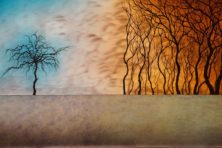The Evolution of Glass Artist Deanna Clayton
- Share
- Tweet
- Pin
- Share

Glass artist Deanna Clayton doesn’t look for traditional ways to create in glass. Twenty-five years into her career as a glass artist, she continues to push the limits of the materials she uses and continues to take artistic risks in pursuit of growth.
“I like to get an idea, and try it, and see what happens,” she said.
Now based in Juddville, Clayton is best known for creating vessels using pâte de verre, meaning “paste of glass”: a term used to describe working with glass particles and a binder. She often combines glass and copper, frequently designed with space between the top and the base.

“Using the copper mesh in the glass is unique to me as far as I have seen,” she said.
Ten years ago, after her father died, Clayton began making heads of solid glass. They reflected her emotional state.
“So the first head was sad, and people said, ‘Whoa, what is this?’” she said. “Doctors would look at them and say they loved the sculpture, but they see that face every day at work and can’t live with it.”
Clayton was known for vessels, so evolving to include figurative work was a risk.
“When you change your work – and for 25 years, I was known for vessels – and I show up with a sad head, well, it takes a long time before people accept what is new,” she said.
But Clayton said she couldn’t force herself to make happy faces when she was going through difficult times in her own life. When her personal life changed course, so did her art: The heads became light, and they started looking up.
Clayton’s process evolves as she works, and she relies on journaling to find the direction she’s going with the torsos.
“I don’t just want to make pretty pieces,” she said. “I want it to have some significance.”
Stephanie Trenchard, an artist in glass and painting at Popelka Trenchard Glass fine-art glass gallery and studio in Sturgeon Bay, admires Clayton’s tenacity.
“It is wonderful for me to have another strong woman in the glass world who is also a neighbor, with whom I can share so many experiences about process, professionalism and fun,” Trenchard said. “Plus I adore her work.”
Shortly before the COVID-19 pandemic canceled shows and exhibits, Clayton had an idea for attaching torsos to the heads, and during lockdown, she had the luxury of time to explore the concept.
“The inspiration for the torso comes from Gustav Klimt – a Viennese painter famous for painting women in elaborate, flowing gowns – but I wasn’t interested in interpreting a lifelike torso that can be read as shoulders, legs and waist,” Clayton said. “For me, it is more the gesture of it, the form under fabric, expressed through color and texture. Robes provide abstraction.
“I have been working on making the figures tall and thin, and I am having success,” she said. “I incorporate copper mesh in the glass, and it holds up the glass. Some of the copper mesh will be embedded in the glass and some exposed.”
When a piece comes out of the kiln, Clayton can also add more copper through electroplating, assembling solid materials from molecules, ions or complexes in a solution to coat an object in a layer of metal.
“The copper gives it strength, and it also warms the glass a little bit,” she said.
Clayton’s work was also affected by the discourse surrounding the nation’s response to the pandemic as well. She made several drawings of groups of people, exploring how the pandemic showed that “people we loved and really cared about didn’t think the same about certain issues,” she said. She began making figures with multiple heads, wrapped together in robe and fabric and trying to exist together in a harmonious way. Some embrace, others face in opposite directions.
“That is what the red piece is about: We are going to live together even if we don’t see eye to eye,” Clayton said. “My artistic dream is to make connections with people and look past all this stuff and get back to humanity. I think I will be working on trying to touch people, although it’s pretty braggy to claim you have achieved such a thing.”
Duncan McClellan of the Duncan McClellan Gallery in St. Petersburg, Florida, lauded Clayton’s distinctive approach.
“Deanna has been a great artist of ours,” McClellan said. “I don’t know anybody else building up the glass particles and incorporating copper. It is a brilliant addition to the work and very popular in our gallery. When she does a master workshop at our place, it sells out in a week.

“The workshops are designed for people who have never worked in glass, although they may be collectors,” he said. “It gives them a much deeper appreciation for how something is made and the difficulties an artist goes through in accomplishing a creation. And then they all walk out in a couple of days with a really beautiful piece.”
Glass is a maturing field, McClellan said, and Clayton an ever-maturing artist.
“Artists are evolving to work with more content, not just beautiful aesthetics,” he explained. “There is meaning behind the pieces, or at least a concept. The artist who transcends the decorative into evoking some kind of message – or more important, taking a particular technique such as Deanna has, and taking it to a new direction – those are the types of artists that our gallery attracts and we look for.”






